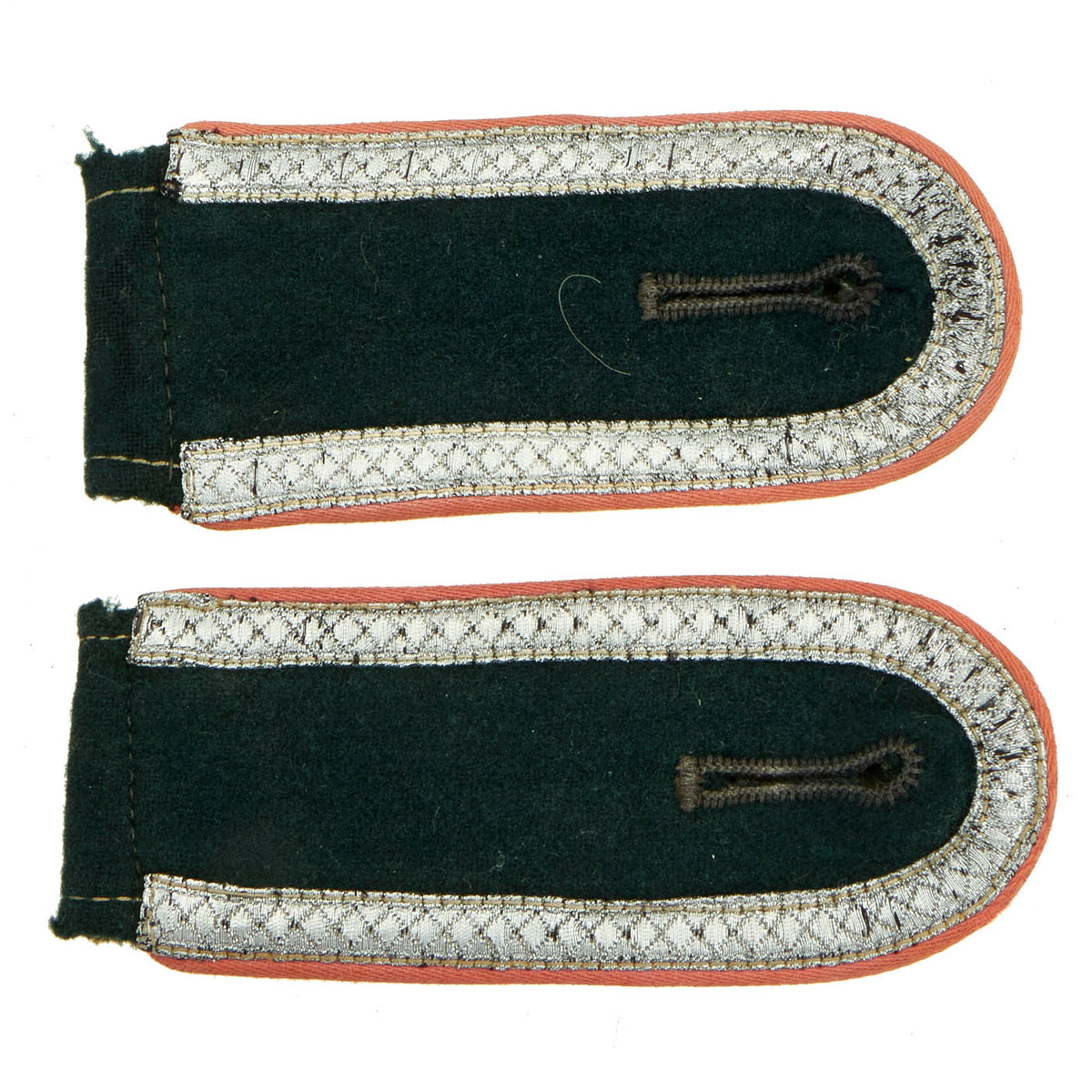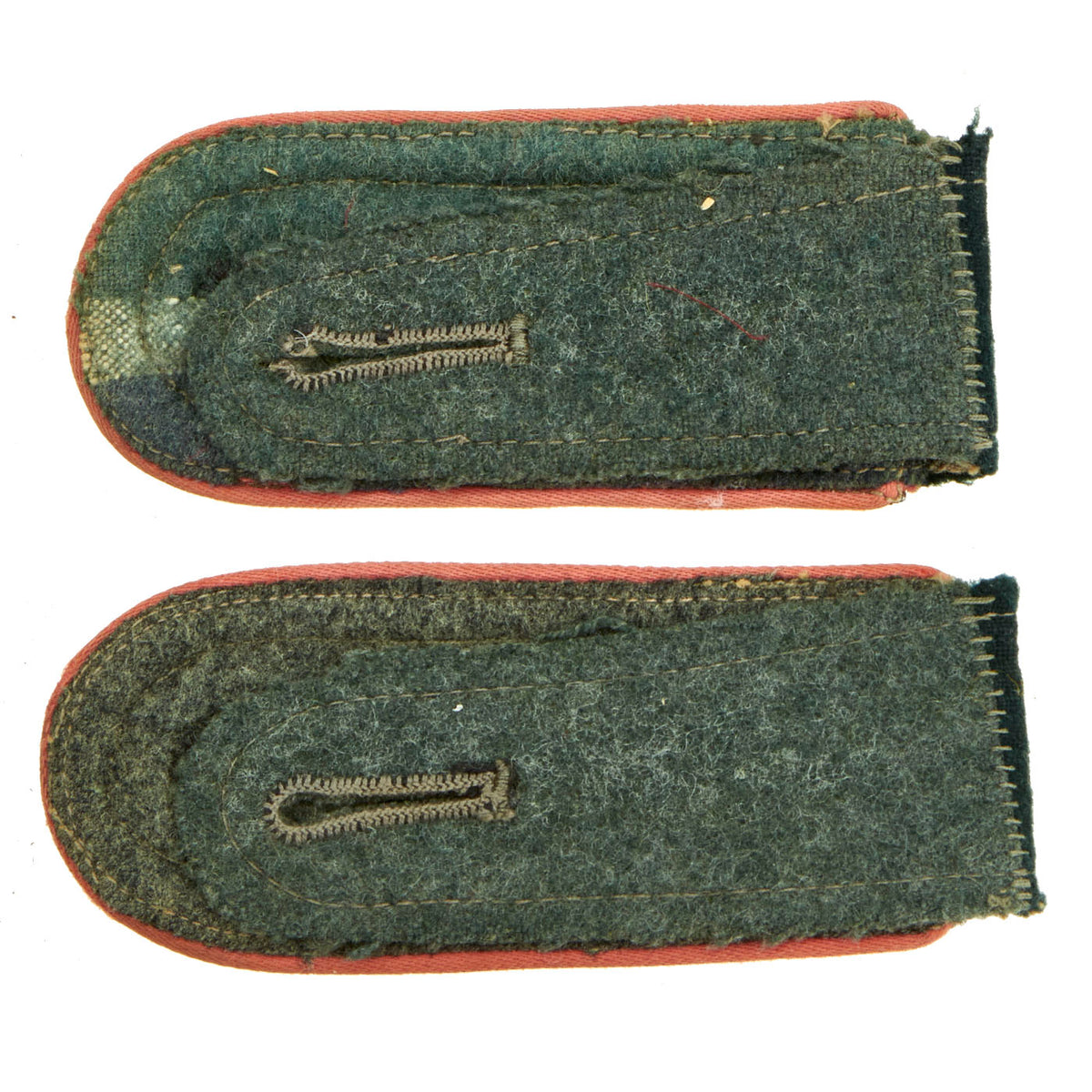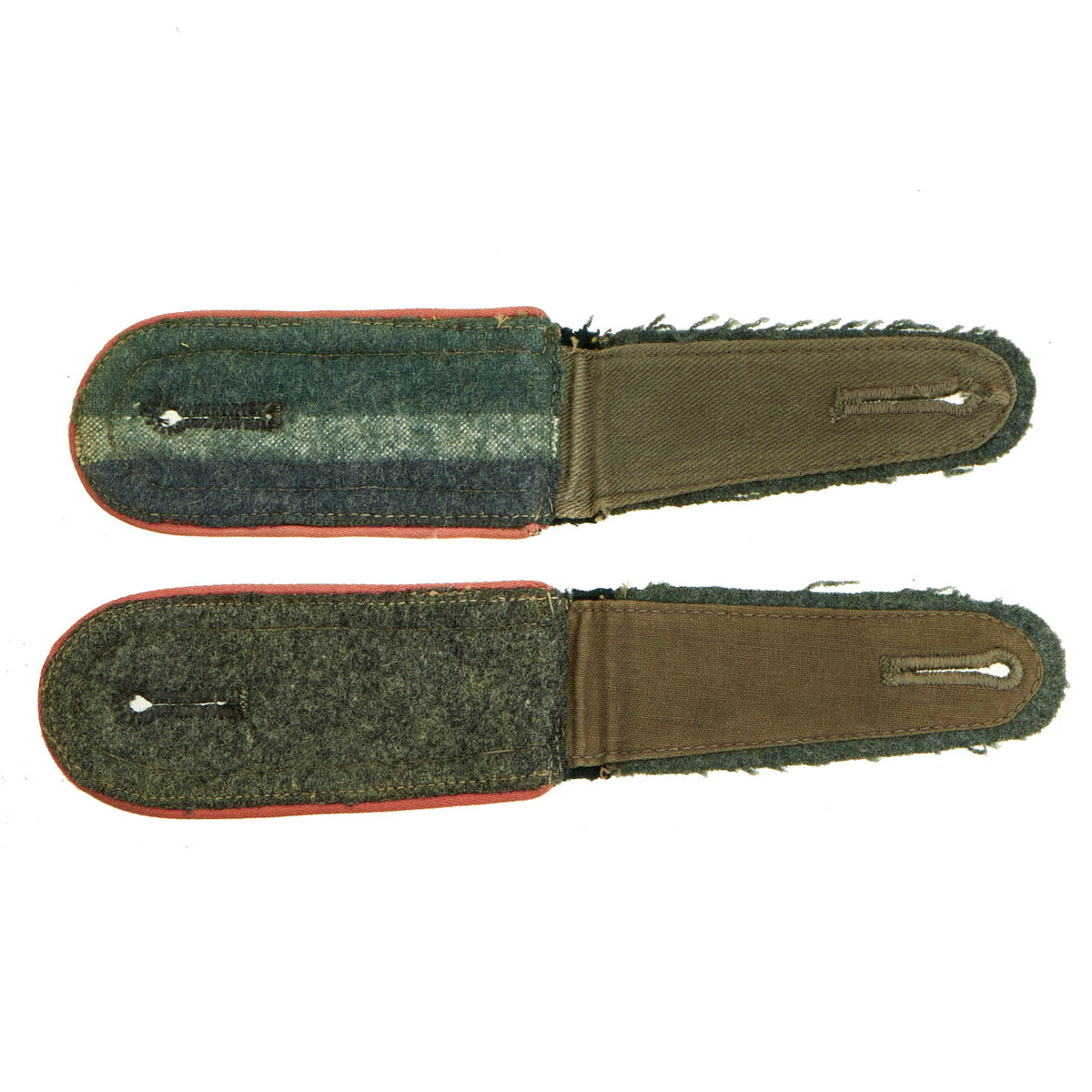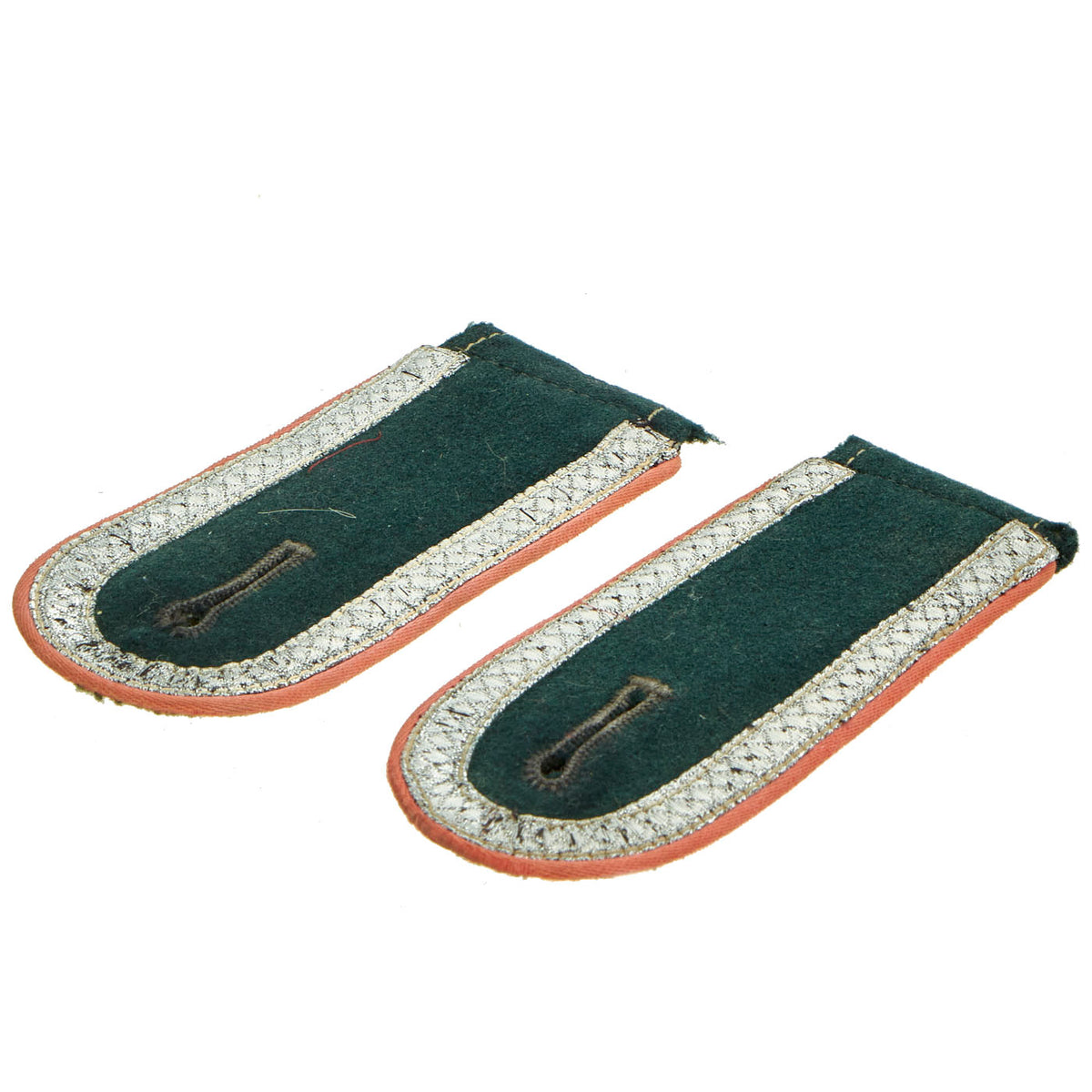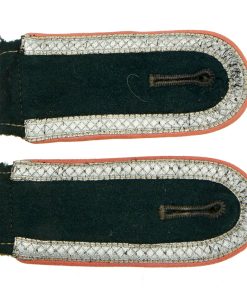Original German WWII HEER Army Panzer Sergeant Rank Shoulder Boards – Unteroffizier Original Items
$ 495,00 $ 148,50
Original Item: Only One Set of 2 Available. This is a very nice set of German WWII Panzer Unteroffizier (Sergeant) Schulterstücken (Shoulderboards). These have the correct woven silver strap around the edge, which leaves the shoulder end open. This is a Non-Commissioned officer rank of the German Wehrmacht Unteroffizier or the U.S. Sergeant, just above Corporal.
This set of shoulder boards have very nice bottle green felt backing and intact straps underneath, for securing them around the shoulder loop. They have Rosa (Rose-pink) piping around the edge, which was the Waffenfarbe (corps color) during WWII for the Panzers (Armored Troops) and Panzerjäger (Tank Destroyers).
There is some light wear and color facing, but these really are a nice set. These would be perfect to dress up any Heer Panzer uniform. Ready to display!
The Heer as the German army and part of the Wehrmacht inherited its uniforms and rank structure from the Reichsheer of the Weimar Republic (1921–1935). There were few alterations and adjustments made as the army grew from a limited peacetime defense force of 100,000 men to a war-fighting force of several million men.
These ranks and insignia were specific to the Heer and in special cases to senior Wehrmacht officers in the independent services; the uniforms and rank systems of the other branches of the Wehrmacht, the Luftwaffe (Air Force) and Kriegsmarine (Navy), were different, as were those of the SS which was a Party organization outside the Wehrmacht. The NSDAP Party also had its own series of paramilitary uniforms and insignia.
The Reichsheer’s shoulder-straps to enlisted men (German: Mannschaften) were very similar to those of World War I, made of feldgrau uniform cloth with pointed or “gable” button ends. In December 1934 the material was changed to gray badge-cloth (Abzeichentuch) and in September 1935 changed again to dark bottle-green (flaschengrün). These “first pattern” shoulder-straps were not edged in Waffenfarbe piping.
In 1938, simultaneous with the removal of Waffenfarbe from field-uniform collar patches, new shoulder-straps were issued. These “second pattern” straps had round rather than pointed ends, and were edged on three sides with wool (later rayon) piping in Waffenfarbe. This pattern would be used through the end of the war, although in 1940 manufacture reverted to field-gray uniform cloth, and as usual alternate versions were made to go with the Panzer uniform (black), tropical uniform (olive cotton) and HBT summer uniform (reed-green twill). Schulterklappen were not worn with the fatigue uniform, nor with camouflage smocks and parkas which used an alternate system of rank insignia.
For junior enlisted men (Mannschaften), rank insignia if any was worn on the left sleeve. However the epaulets did indicate the wearer’s unit (usually regiment or independent battalion) together with his sub-branch if any, machine-embroidered in branch-color. For example, a Schulterklappe with rose-pink piping and number “4” would indicate the 4th Panzer Regiment; but if it carried a pink number “4” and letter “A” it would indicate the 4th Armored Reconnaissance (Aufklärungs) Battalion. The German Army used a very large assortment of Latin initials, Gothic initials, script ciphers, Arabic numerals, Roman numerals and symbols to designate all its various service branches and installations. Before the war, shoulder-buttons were embossed with the number of the wearer’s company as well, this practice was discontinued “for the duration.”
Beginning in January 1940, shoulder-straps with unit insignia were (supposed to be) phased out as a security measure, and removable fabric loops with devices were issued instead. In May 1944 the embroidery was changed from waffenfarbe to light gray.
Officers’ shoulder boards were constructed from “Russia” braid, an aluminum-thread double piping. Company-grade officers (Leutnant through Hauptmann/Rittmeister) wore epaulets constructed by wrapping two side-by-side lengths of braid around the buttonhole and back, giving the appearance of eight parallel cords; the whole was sewn to an underlay (Unterlagen) of Waffenfarbe badge-cloth. Until 1938 the underlay was of the same outer dimensions as the braid, and only visible edge-on; in that year the underlay was made wider, so as to create the impression of edge piping like the enlisted shoulder-strap. Rank was indicated by zero to two gilt-metal rank stars; unit designators were also of gilt metal.
Field-grade officer (Stabsoffizier) shoulder boards were made by plaiting together double widths of Russia braid and looping them to form a buttonhole, sewn to a Waffenfarbe underlay; rank again was displayed by zero to two gilt stars.
Once the war began, dull gray aluminum braids appeared, but bright aluminum continued in use.
Fast Shipping with Professional Packaging
Thanks to our longstanding association with UPS FedEx DHL, and other major international carriers, we are able to provide a range of shipping options. Our warehouse staff is expertly trained and will wrap your products according to our exact and precise specifications. Prior to shipping, your goods will be thoroughly examined and securely secured. We ship to thousands clients each day across multiple countries. This shows how we're dedicated to be the largest retailer on the internet. Warehouses and distribution centres can be located throughout Europe as well as the USA.
Note: Orders with more than one item will be assigned a processing date depending on the item.
Before shipping before shipping, we'll conduct a thorough inspection of the items you have ordered. Today, the majority of orders will be delivered within 48 hours. The delivery time will be between 3-7 days.
Returns
The stock is dynamic and we cannot completely manage it because multiple stakeholders are involved, including our factory and warehouse. So the actual stock may alter at any time. It's possible that you may not receive your order once the order has been made.
Our policy is valid for a period of 30 days. If you don't receive the product within 30 days, we are not able to issue a refund or an exchange.
You can only return an item if it is unused and in the same state as the day you received it. You must have the item in its original packaging.
Related products
Uncategorized
Armored Burgonet Helmet & Polearm from Scottish Castle Leith Hall Circa 1700 Original Items
Uncategorized
Uncategorized
Uncategorized
Uncategorized
Armoured Fighting Vehicles of the World: AFVs of World War One (Hardcover Book) New Made Items
Uncategorized
Uncategorized
Uncategorized
Uncategorized
Australian WWII Owen MK1 Machine Carbine SMG Custom Fabricated Replica with Sling Original Items
Uncategorized
Uncategorized
Uncategorized
Uncategorized
Uncategorized
Uncategorized
Uncategorized
Uncategorized
